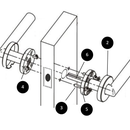Introduction: Recyled Timber Dining Table
The first step is to work out your table dimensions. In terms of height we have used 750mm, although this can be adjusted based on your preferences and in particular to suit chair height if you already have the chairs. Factor in key things such as
- Number of people you want to be able to sit around the table
- Space for each person’s space and space in the middle for shared food.
- Locations of the legs in from the end, so they don’t get in the way of people sitting
See attached plans for the dimensions we used which comfortably sit 8 people. It’s a little wider then some tables and this was due to the size of the room, which allowed a slightly wider table.
The thickness of the timber for the top will also impact your dimensions. Our recycled timber is 40mm thick. The timber we used is called 'messmate'.
Step 1: Step 2: Legs
If you plan well and work out all the dimensions and cuts, the legs can be pretty simple to put together.
Essentially, they’re 2 crossed pieces of wood at each end which a straight piece joining them. We used 100mm x 100mm new pine here. As they’re being stained black, we did not need to get recycled wood to match the top.
Firstly, you need to work out your angles you cut the bottom and top of each leg to. Your overall table size will dictate this. This angle is also the same angle as the notched section joining each leg into a set.
Using a carboard or paper template and drawing on each leg is a big help in working out the angles and exact location of each cut/notch where the legs intersect
Secondly, each criss-crossed leg is notched into each other. The depth of each notch is half the thickness of the timber, so in this case 50mm deep. A straightforward way to do the notch is to set your circular saw to a dept of 50mm and cut a series of cuts close to each other. Then use a hammer and chisel to chisel it out cleanly.
The exact opposite side of the leg is also notched to a depth of 10mm. This is where the timber that joins each set of crossed legs will sit. This notch is of course 100mm x 100mm
Each leg will fit snuggly into the notch. You can glue them in here, or if you ever want to disassemble the legs you can simply screw them with 1 screw in the end.
Once you have 2 sets of criss-crossed legs, fit the timber joining each set of legs. This sits in the 10mm notch on each set of legs and is screwed in from the end of the legs. This screw (we used exterior 75mm hex screw) can hold both the 2 notched legs in place and the timber joining each set all in one go. Recess this screw into the timber for a cleaner look.
Step 2: Step 3: Table Top- Joining Boards
This is the most important and difficult part. If you’re using recycled wood, the straighter the wood the easier this is, the more ‘rustic’ the more difficult it can be.
Lay out your timber side by side to get the overall width worked out. You do not need to cut each board to length at this stage, this is better done at the end after the boards are attached to each other to get a straighter edge
Boards are attached to each-other with timber dowel and glue. Here we used 8mm dowel and wood liquid nails glue. Mark the location of each hold on the sides of the boards. Here we used 8 dowel fixing points along each board. So we drilled 8 holes on both sides of each board (except the 2 outside boards, which if course only have holes on the inside length)
It is critical these holes are 1. drilled straight and 2. In the exact same location on each board. Any deviation to this and lining up the dowel will make fixing the boards together more difficult. So, measure carefully and use a drill press to drill the holes if you have one.
Squirt glue into the holes on the first 2 boards, insert dowel into one of the boards and begin pushing those boards together. 2 long clamps are very useful in pushing the boards together as tight as you can. You want a minimal gap when the boards are together for aesthetic purposes.
Now do the same with the 3rd board to attach it to the first 2 and so on. Once all boards are together leave the clamps on for at least 24 hours.
Once dry you can remove the clamps, and run the circular saw along each end to clean up the ends of the table.
Step 3: Step 4: Assembly
If you are staining the legs it is better to stain them before assembling the top, as we did, so you can move the legs around and upside down etc which will be harder to do once the top is on.
To attach the top to the legs, simply used screws and recess them in from the top of the legs up into the table top. Ensure your screw lengths are correct so you don’t through up through the top of the table. Glue can be used although if you ever want to disassemble the table to move it, it’s best not to glue it.
Step 5: Sanding and staining
Now you can run your belt sander or orbital sander over the top of the table. Depending on how ‘rustic’ a finish you’re after, will determine how much sanding is required. Ensure you do sand the edges both on the top edge and understand so those sitting at your table don’t get splinters or cuts from a sharp edge!
Staining: For this table we used Tung Oil to give it a protective coating but also a natural finish where you can still feel the grain.
Instructable from hardwarebox.com.au











